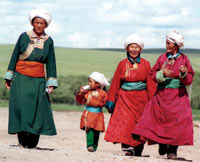
Mongolians
There are some 4.8 million Mongolians in China today - none of them the weapon wielding type like in the old days. Due to the extensive military campaigns of their forefathers, these descendants now live as far south as Yunnan (in southwestern China), as far north as Lake Baikal in Russia (the Buriats), as far west as southwestern Russia (the Kalmyks), Afghanistan (the Moghols) and Xinjiang (the Oirats). Most reside in the Inner Mongolian Autonomous Region in China's north and in Mongolia.
The greatness of the Mongol empire stirred literary imaginations the world over. Marco Polo, who was the first European to serve in Kublai Khan's court, wrote in his reports about Dadu, the winter capital of the Mongols. The famous Italian explorer, who served the Khan for 16 years, called Dadu "Cambalu" meaning "City of the Khan". Even well known English poet Samuel Taylor Coleridge, weaved this fabled city into his enigmatic poem, "Kublai Khan."

Under Kublai Khan's Yuan dynasty, cultural exchange between China and the rest of the world flourished. Kublai allowed Tibetans lamas (priests), Christian and Catholic missionaries, Muslims and Hindus to practice their faith. Traditional Chinese philosophies like Confucianism were tolerated and much of Chinese culture survived Mongol reign.
The Mongols favored Tibetan Buddhism. They set up Buddhist monasteries to serve the religious needs of Mongol communities. Today, Buddhist monasteries in the Mongolian communities of Inner Mongolia continue to teach the scriptures via the Mongol script. At that time, lamas, especially high-ranking ones, were part of the feudal upper class, and granted titles and special privileges by the state, such as exemption from army conscription. During the Ming and Qing dynasties - a period of 543 years - close to one-third of the Mongolian population became Tibetan lamas. They neither married nor did any physical labor, which subsequently impeded the development of production and the population growth of the Mongolian community.
Even as the Mongols adopted some Chinese political systems and a Chinese dynastic name, they refused to learn the native language, and therefore, never successfully integrated with the Chinese. The Forbidden City, built by Kublai Khan, was in those days a sanctuary of Mongolian culture. Built in Arabic, Central Asian, Chinese, and Mongolian architectural elements, it contained traditional Mongolian yurt tents and a playing field for their horsemen. Its aloofness however was symbolic of the divide between the Chinese and their Mongolian occupiers.
|

![]() 北京市通信公司提供网络带宽
北京市通信公司提供网络带宽
